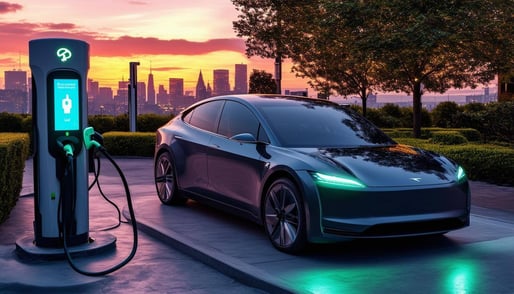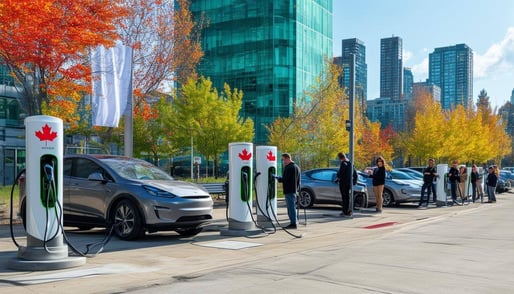Navigate the electrifying world of EV charging with our comprehensive guide designed for new and prospective electric vehicle owners.
Understanding the Basics of EV Charging
Electric Vehicle (EV) charging refers to the process of replenishing the battery of an electric vehicle. It is similar to refuelling a conventional car, but instead of filling up with gasoline or diesel, an EV needs to be charged with electricity.
EV charging can be done at home, at work, or at public charging stations. The charging time and speed depend on the type of charger used and the capacity of the vehicle's battery.
There are three main levels of EV charging: Level 1, Level 2, and DC Fast Charging. Level 1 charging uses a standard household outlet (120 volts) and is the slowest method. Level 2 charging requires a dedicated charging station (240 volts) and provides faster charging times. DC Fast Charging, also known as Level 3 charging, is the fastest option and is typically found at public charging stations.
It's important to note that not all electric vehicles are compatible with DC Fast Charging. Some models may require an additional adapter or have limitations on the charging speed.
Understanding the basics of EV charging is crucial for electric vehicle owners to effectively charge their vehicles and plan their charging needs.
Types of EV Chargers: From Level 1 to DC Fast Charging
Understanding the different types of electric vehicle (EV) chargers is crucial for both EV owners and those considering making the switch. Here's a breakdown of the three main charging levels, including their power output measured in kilowatts (kW).
Level 1 Charging
Power Output: Up to 1.4 kW (120 volts)
Level 1 charging is the slowest method of charging an electric vehicle. It uses a standard household outlet (120 volts) and typically provides charging power up to 1.4 kW. This results in approximately 3 to 5 miles (5 to 8 kilometers) of range per hour of charging. Level 1 chargers are usually included with the purchase of an electric vehicle and are convenient for overnight charging at home or when a dedicated charging station isn't available.

Level 2 Charging
Power Output: Ranges from 3.3 kW to 19.2 kW (240 volts)
Level 2 charging requires a dedicated charging station connected to a 240-volt outlet, similar to those used for heavy-duty appliances like electric dryers. These chargers provide significantly faster charging times compared to Level 1. Depending on the vehicle and charger specifications, Level 2 charging can provide approximately 10 to 30 miles (16 to 48 kilometers) of range per hour of charging. Many public charging stations, workplaces, and residential installations offer Level 2 charging, making it ideal for daily charging needs, especially for those with longer commutes.
.png?width=635&height=792&name=AX%20%26%20AW%20(edited).png)
DC Fast Charging (Level 3 Charging)
Power Output: Typically ranges from 50 kW up to 350 kW
DC Fast Charging is the fastest charging option available for electric vehicles. It uses high-powered chargers to provide rapid charging by delivering direct current (DC) power directly to the vehicle's battery, bypassing the onboard charger. DC Fast Chargers can significantly reduce charging times, allowing drivers to charge their vehicles to 80% capacity in as little as 20 to 40 minutes. The exact time depends on the vehicle's battery capacity and the charger's power output. DC Fast Charging stations are typically found at public locations such as rest areas, shopping centers, and highway service areas, making them useful for long-distance travel or when a quick charge is needed.

Summary of Charging Levels and Power Outputs:
- Level 1 Charging: Up to 1.4 kW; 3-5 miles of range per hour.
- Level 2 Charging: 3.3 kW to 19.2 kW; 10-30 miles of range per hour.
- DC Fast Charging: 50 kW to 350 kW; 80% charge in 20-50 minutes.
Each type of EV charger has its own benefits and considerations:
-
Level 1 Charging is convenient and requires no special equipment, but it's slow and best suited for overnight charging or low daily mileage.
-
Level 2 Charging offers a balance between speed and convenience, ideal for daily charging at home, workplaces, or public locations.
-
DC Fast Charging provides the fastest charging speeds, making it ideal for road trips or when you need a quick charge, but it requires specialized equipment and is less common.
Choosing the Right Charger for Your Needs
When considering an electric vehicle, it's important to assess your charging needs based on:
- Driving Habits: Daily commute distance, frequency of long trips.
- Access to Charging Infrastructure: Availability of home charging setup, workplace charging, and public charging stations.
- Vehicle Specifications: Not all EVs can accept the highest charging speeds; check your vehicle's maximum charging capacity.
By understanding the differences in charging levels and their power outputs, you can make informed decisions that fit your lifestyle and ensure a convenient and efficient EV ownership experience.
Check out our charger selection guide for more information.
The Cost of Charging an Electric Vehicle
The cost of charging an electric vehicle depends on various factors, including electricity rates, charger type, and the capacity of the vehicle's battery.
To determine the cost of charging your electric vehicle at home, you will need to multiply the electricity rate (cost per kilowatt-hour - kWh) by the charging speed of your charger (most level 2 home chargers operate at 32A, which is approximately 6.7kWs per hour), and then by the duration of your charging session.
For example, if the electricity rate is $0.20 per kilowatt-hour (kWh) and your charger operates at 6.7 kilowatts per hour, we would multiply $0.20 by 6.7kW for an approximate hourly rate of $1.34.
At this rate, an 8-hour charging session would cost you approximately $10.72 for approximately 53kWs of energy. If your car has a 100kW battery, then you will be replenishing at least half of it's battery, or roughly 225 km (140 mi) of range.
As mentioned, there are variables that will impact the above figures, if you are paying per kWh consumed. As the battery does not draw power at the same rate throughout it's charging process. When the battery gets closer to full it draws power more slowly, decreasing the kW usage per hour, thereby making your overall cost less.
Public charging stations may have different pricing structures, such as per kilowatt-hour or per minute of charging. Some stations offer free charging, while others require a subscription or payment. It's important to check the pricing details before using a public charging station.
The overall cost of charging an electric vehicle is generally lower compared to the cost of refuelling a conventional car with gasoline or diesel. Additionally, some electric utilities offer special rates or incentives for EV owners, further reducing the cost of charging.
It's worth noting that the cost of charging can vary depending on the location and electricity rates. It's recommended to consult with local electric utilities or charging providers to get accurate cost estimates for your specific area. BC Hydro has a tool to help calculate your fuel savings with an EV over an internal combustion engine vehicle.
How to Find and Use Public EV Charging Stations
Finding and using public EV charging stations is becoming increasingly easier as the charging infrastructure continues to expand.
There are several ways to locate public EV charging stations:
- Use mobile apps or websites dedicated to EV charging station maps, such as PlugShare. These platforms provide real-time information on the availability, location, and type of charging stations near your current or desired destination.
- Check with local electric utilities, like BC Hydro, or government websites, like NRCAN, for charging station directories. They often provide updated lists of public charging stations in the area.
- Electric vehicle manufacturers may have their own charging station locator tools on their websites or mobile apps.
Once you've located a public charging station, follow these steps to use it:
- Park your electric vehicle in the designated charging spot.
- Check the station's connector type and ensure it is compatible with your vehicle. Most stations support multiple connector types such as CHAdeMO, CCS, or Tesla Supercharger.
- Plug the charging cable into your vehicle's charging port and the charging station's connector.
- If required, initiate the charging session by following the instructions on the charging station or using a mobile app.
- Wait for the charging session to begin. Some stations may require authentication or payment before starting the charging process.
- Once the charging session is complete, unplug the charging cable from both the vehicle and the charging station.
It's important to be mindful of any parking restrictions or time limits at public charging stations to ensure fair access for all EV drivers. Remember to always leave the charging spot available for other users once your charging session is finished.
Future Trends in EV Charging Technology
The field of EV charging technology is constantly evolving, with new advancements and innovations on the horizon. Here are some future trends to watch out for:
- Increased charging speeds: As technology improves, faster charging speeds are expected, reducing the time required to charge an electric vehicle.
- Wireless charging: Wireless charging technology for electric vehicles is being explored, eliminating the need for physical charging cables and connectors.
- Vehicle-to-Grid (V2G) integration: V2G technology allows electric vehicles to not only draw power from the grid but also feed excess energy back into the grid when needed. This enables vehicles to serve as mobile energy storage units.
- Smart charging and grid integration: Smart charging systems can optimize charging based on electricity demand, grid capacity, and renewable energy availability. This helps to balance the load on the grid and maximize the use of renewable energy sources.
- Improved charging infrastructure: The number of public charging stations is expected to increase, providing more convenience and accessibility for electric vehicle owners.
These future trends in EV charging technology aim to enhance the charging experience, reduce charging times, and further integrate electric vehicles into the overall energy ecosystem.
As technology continues to advance, electric vehicle owners can look forward to a more seamless and efficient charging process.
Tags:
How much does EV charging cost?, Level 1 vs Level 2 Charging, EV Charging, Cost to charge an electric vehicle, Level 2 vs DCFC EV ChargingJul 23, 2024 6:29:06 PM


%20and%20a%20Gasoline%20Car.%20The%20background%20.webp?width=520&height=294&name=DALL%C2%B7E%202024-12-09%2016.08.44%20-%20A%20clean%20and%20minimalistic%20infographic%20design%20comparing%20the%20cost%20per%20litre%20of%20traveling%20for%20an%20Electric%20Vehicle%20(EV)%20and%20a%20Gasoline%20Car.%20The%20background%20.webp)
Comments